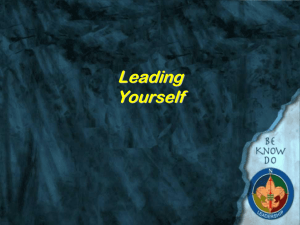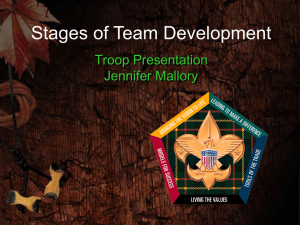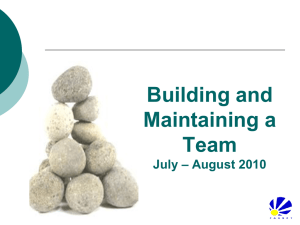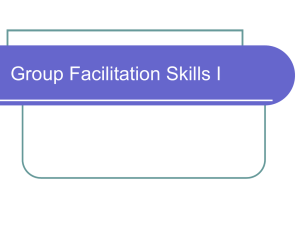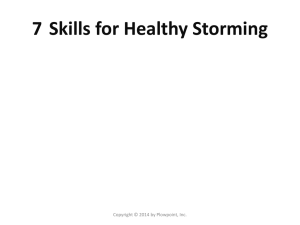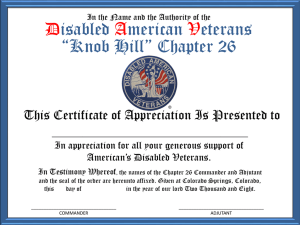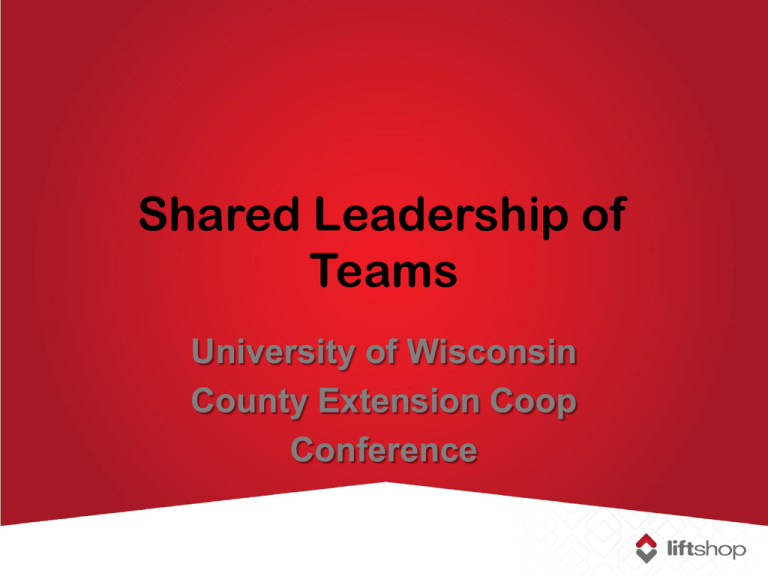
Shared Leadership of
Teams
University of Wisconsin
County Extension Coop
Conference
Objectives
• Outline what is Shared Leadership
• Understand needs of the team for each stage of
development.
– Why and how to develop Cohesion
– The importance of Confidence
– Ensuring Collaboration
• Awareness of tools to develop “shared
leadership” and progress the team.
• Apply the learning and outline actions to take
Agenda
•
•
•
•
•
•
Shared Leadership? ? ?
Stages of Development
Building Cohesion
Instilling Confidence
Ensuring Collaboration
And. . .
What’s On Your Mind?
Shared Leadership? ? ?
• How much?
– A little
– Some
– Everything
• When?
• How?
Shared Leadership
• Influence vs. Authority
• Facilitation vs. Direction
• Team vs. Task Focus
When to Influence
• You need help from someone over whom
you have not authority.
• Other(s) are resisting helping you.
• You don’t have a good relationship with
the person from whom you need help.
• You don’t know the other person well.
OWN
DO
TRY
KNOW
LEVEL OF COMMITMENT
Influence
TELL
ADVISE
SUGGEST
CONSULT FACILITATE
INFLUENCE
Influence Steps*
•
•
•
•
Assume all are potential allies
Clarify your goals and priorities
Diagnose the world of the other person
Identify relevant “currencies” theirs and
yours
• Deal with relationships
• Influence through give and take
*Cohen – Bradford Influence Model
Stages of Team Development
Team Development Stages
STAGES OF DEVELOPMENT
TEAM
GOAL
STAGE of
DEVELOPMENT
Cohesion
Confidence
Collaboration
Commitment
FORM
STORM
NORM
PERFORM
Stages and Development Activities
Cohesion
Confidence
Team Kick-off
Session
Strengths
Workshop
Preference
Workshop
Team Norms
Collaboration Commitment
Recognition /
Appreciation
Conflict
Resolution
Leader
Assimilation
Session
FORMING
STORMING
NORMING
Team Identity
Team
Assessment
and
Measurement
PERFORMING
DIAGNOSING
TEAM STAGES
Team Diagnosis – 4 Dimensions
FORMING
RELATIONSHIP
COMMUNICATION
DECISIONS
ORGANIZATION
STORMING
NORMING
PERFORMING
COHESION - FORMING
Team Diagnosis
FORMING
RELATIONSHIP
COMMUNICATION
DECISIONS
ORGANIZATION
STORMING
NORMING
PERFORMING
Team Diagnosis – Forming
FORMING
RELATIONSHIP
ORGANIZATION
LED
DECISIONS
LEADER
COMMUNICATION
STORMING
NORMING
PERFORMING
Cohesion Model
TEAM “ROLES”
ROLES
Cheerleader
Devil’s Advocate
Facilitator
Historian
Mentor / Advisor
Sargent at Arms
Spokesperson
TEAM “ROLES”
ROLES
Cheerleader
Devil’s Advocate
Facilitator
Historian
Mentor / Advisor
Sargent at Arms
Spokesperson
WHEN OVERUSED
“Pollyanna’
Cynic
Mother Hen
Traditionalist – “this is
the way we’ve always
done it”
Dictator
Self Promoter
Cohesion
• Kick-off
• Preferences – Self Assessments
• Leader Assimilation
Kick-Off
• Face-to-Face . . . or Live
• Sponsorship
Preferences - Self Assessments
Principles of Preference
• If you don’t know what to do, you will do what
you know, what you prefer.
• In times of stress, you will default to your
strength.
• Any strength taken to an extreme, can be
dysfunctional.
• Balance comes from broadening your
preference - not lessening it.
• It is difficult to change more one preference
at a time.
CONFIDENCE - STORMING
Team Diagnosis
FORMING
STORMING
RELATIONSHIP
COMMUNICATION
DECISIONS
ORGANIZATION
?
NORMING
PERFORMING
STORMING
STAGE
BEHAVIORS
RELATIONSHIPS
•
•
•
•
Alliances are formed.
Difference of opinions arise.
Competition and conflict may develop.
Personalities influence team efforts.
INFORMATION
•
•
•
Teams take on responsibility,
Individuals struggle for control.
Members may withhold information as a form of control.
•
•
There is greater willingness to state Ideas and decisions take more
time
Team members may show displeasure with decisions.
•
•
•
The team may be Perceived to be in chaos.
Concern for whether or not the team will accomplish their goal.
Management may question the worth of the team.
•
•
•
•
How will I seek autonomy?
How much control will I have? Over my work? Over others?
Who do I support? Who supports me?
How much influence do I have?
DECISION
ORGANIZATION
QUESTIONS
27
Confidence - Storming
• Strengths
• Norms
Why Confidence?
Confidence Builders
• Leverage Your Strengths
• Reflective development
• Interrogative Question
– Will I? Will we?
– Can I? Can we?
Why FOCUS on STRENGTHS?
Focusing on strengths, rather than weaknesses,
removes disengagement from teams.
Impact of Strengths-Focus on
Disengagement
22 of 100
disengaged
1 of 100
disengaged
Focus on Weaknesses
© StrengthsTest.com. All Rights Reserved.
Focus on Strengths
Source: Gallup Organization; StrengthsFinder 2.0
Business Case: Engagement
Teams who pursue strengthsbased development realize a
increase in engagement levels…
Employee Engagement
…and retention of team
members.
Intent-to-Stay
10x increase
2.3x increase
No strengths-based
development
With strengths-based
development
Source: Gallup Organization; StrengthsFinder 2.0
No strengths-based
development
With strengths-based
development
Norms
• Values vs Behaviors
• Four Dimensions
• Leverage Preference
Norms Example – Relationships
•
•
•
•
•
•
•
RELATIONSHIPS
Offer candid, honest opinions.
Once decision is made,
support the teams decision.
Direct feedback. Be specific,
timely, with a positive intent.
Listen for clarity. Listen to
understand others POV, state
of mind, state of emotion
Encourage and ask for
different POV. Encourage
constructive dissent.
Allow venting and seek for
permission to vent.
Face time is un-interrupted.
Have FUN! Plan for it.
Reinforce it when it happens.
•
•
•
•
•
•
MEETINGS
Arrive on time to meetings
Come prepared to fulfill the
meeting agenda (i.e. discuss
agenda topic, present
information or make decisions)
Everyone is given an opportunity
to speak on an issue before a
decision is made.
What is said in meetings stays in
meetings unless otherwise
agreed to by the team.
If you miss a meeting, support
decisions made in your absence
Do not monopolize discussions.
Limit your air time to less than
one minute.
Norm Example – Sharing Information
TECHNOLOGY
COMMMUNICATION
•
Dealing with urgency. (Define urgency)
Face-to-face is first option, live via cell
phone is second, voice mail last.
•
Call person if after two email requests
there is no response.
•
Only request information in one way
(email, VMX, phone or face-to-face).
Be consistent and ask for same
method for same info each time.
•
•
•
Over-communicate team decisions to
stakeholders. Identify which
stakeholders need to know and who
on team will communicate decision.
Email
•
•
•
•
•
No files over 1 MB – Use
Sharepoint – send a link
Use for detailed requests
Limit use of Reply All. Make sure
email audience is correct before
pushing send
If email are sent back & forth 2 or
more times – call or address face
to face.
Respond to emails/voicemails
within 48 hours. If you don’t have
the answer, let them know when
you will get it.
IM (Instant Messaging)
•
•
Use for quick questions
Use as a communication tool to
team members on conference
calls
Self-service. Don’t request info if you
can get it yourself.
Phone
Ok to say NO. Or not in time
requested. Offer alternative time if
possible.
•
•
If urgent & important allow
reasonable response time
“Keep you out of office” current
COLLABORATION - NORMING
Stages and Development Activities
Cohesion
Confidence
Team Kick-off
Session
Strengths
Workshop
Preference
Workshop
Team Norms
Collaboration Commitment
Recognition /
Appreciation
Conflict
Resolution
Leader
Assimilation
Session
FORMING
STORMING
NORMING
Team Identity
Team
Assessment
and
Measurement
PERFORMING
Team Diagnosis
FORMING
STORMING
NORMING
RELATIONSHIP
COMMUNICATION
DECISIONS
ORGANIZATION
?
PERFORMING
NORMING
STAGE
BEHAVIORS
•
•
•
Team meets regularly.
High levels of cooperation.
Team can function Independently
INFORMATION
•
•
•
Teams exhibit more independence
Team is resourceful and can obtain information on their own.
Information is freely exchanged.
DECISION
•
•
•
Teams exhibit more independence
Team is resourceful and can obtain information on their own.
Information is freely exchanged
•
•
•
•
High commitment level to the team
Goals are defined.
Productivity and quality increase.
Team shares responsibilities.
•
•
•
•
Will we be successful as a team?
How do we measure up to other teams?
What is my relationship to the team leader?
What kind of relationships can we develop?
RELATIONSHIPS
ORGANIZATION
QUESTIONS
39
What is Collaboration?
Collaboration - Norming
• Recognition / Appreciation
• Conflict Resolution
5 Languages of Appreciation in
the Workplace
The Language of Appreciation
• Words of Affirmation
• Tangible Gifts
• Quality Time
• Acts of Service
From “The 5 Languages of Appreciation in the Workplace”, Chapman and White
Words of Affirmation
• Praise for Accomplishments
• Affirmation for Character
• Words that focus on Positive Personality
Traits
From “The 5 Languages of Appreciation in the Workplace”, Chapman and White
Words of Affirmation
How to –
• Personal – One to One
• In front of others
• Written affirmation for Character
• Public affirmation
From “The 5 Languages of Appreciation in the Workplace”, Chapman and White
Quality Time
• Quality Conversation
• Shared Experiences
• Small Group Dialogue
• Working closely with others in
accomplishing a project
From “The 5 Languages of Appreciation in the Workplace”, Chapman and White
Acts Of Service
• Ask before you help
• Serve voluntarily
• Have a positive, cheerful attitude
• Do it their way
• Complete what you start
• Don’t neglect your own responsibilities
From “The 5 Languages of Appreciation in the Workplace”, Chapman and White
Tangible Gifts
• Give gifts primarily to those who
appreciate them
• Give gifts the individual values
From “The 5 Languages of Appreciation in the Workplace”, Chapman and White
Discovering Other’s Language
• Observe their behavior
• Observe their requests of others
• Listen to their complaints
Conflict
• Expect – Plan - Balance
• Language / Process
Balancing Contention
COOPERATION
CONTENTION
CONFLICT
Conflict Confront Prep
• Sort your emotion
• Evaluate the relationship
• Know your intention
• Anticipate reactions
Intentions - Confronting Conflict
•
•
•
•
•
•
•
•
•
Make it worse
Relieve the pressure
Get closure
Win
Dominate
Reinforce the problem
Drive someone away
Intimidate
Compromise
• Improve (but not
resolve)
• Be right
• Survive
• Escape
• Avoid
• Resolve it for both
sides
• Convince them
Conflict Principles
•
•
•
•
•
•
Talk face-to-face and in private.
Assume the best of others.
Use tentative language.
Share facts not conclusions.
Ask for their view..
Use equal treatment.
Balancing Contention
Type
ANALYTICAL
Orientation
Informationoriented,
direct
STRUCTURAL
Taskoriented,
direct
SOCIAL
Peopleoriented,
indirect
CONCEPTUAL
•
Idea-oriented,
indirect
What You Seek
How to Balance
Authority and
control
Avoid a debate. Don’t just focus on the facts at
hand. Consider the emotions of the other
person. Allow them to express their
thoughts and feelings. Listen with
empathy. Demonstrate your concern, show
your support
Accuracy and
precision
Be open to impromptu, spontaneous
discussions if the employee initiates the
conversation. Don’t dominate the
conversation
Relationships and
reputation
Affiliation and
stability
Be direct. Be careful not to acquiesce during
difficult conversations or potential conflict.
Plan out what you want to say and plan
time for others to respond.
Don’t neglect historical, relevant information.
Focus on the topic at hand. Avoid
tangents.
How you give/receive feedback is greatly influenced by your and the other person’s job
function, gender, race, age, and whether it is upward or downward feedback.
Team Development Stages
STAGES OF DEVELOPMENT
TEAM
GOAL
STAGE of
DEVELOPMENT
Cohesion
Confidence
Collaboration
Commitment
FORM
STORM
NORM
PERFORM
Stages and Development Activities
Cohesion
Confidence
Team Kick-off
Session
Strengths
Workshop
Preference
Workshop
Team Norms
Collaboration Commitment
Recognition /
Appreciation
Conflict
Resolution
Leader
Assimilation
Session
FORMING
STORMING
NORMING
Team Identity
Team
Assessment
and
Measurement
PERFORMING
Objectives
• Understand needs of the team for each
stage of development.
– Why and how to develop Cohesion
– The importance of Confidence
– Ensuring Collaboration
• Awareness of tools to develop “shared
leadership” and progress the team.
• Apply the learning and outline actions to
take
APPENDIX
Influence Steps
•
•
•
•
Assume all are potential allies
Clarify your goals and priorities
Diagnose the world of the other person
Identify relevant “currencies” theirs and
yours
• Deal with relationships
• Influence through give and take
*Cohen – Bradford Influence Model
Diagnose the World of the Other
• How is this person measured?
• What are their primary responsibilities?
• Does this person experience pressure? If
so, from who?
• What does this person’s boss expect from
them?
• What seems important to this person?
Five Types of “Currencies”
What Matters to your “Ally”:
• Inspiration Related – provide meaning
• Task Related – provide resources, help
• Position Related – recognition
• Relationship Related – feel connected
• Personal Related – show gratitude
Gaining Commitment
AWARENESS
• Tell
• Advise
INTEREST /
TRIAL
• Show
• Try
REPEAT
• Suggest
• Consult
COMMITMENT
• Ask
• Support
Facilitation Opportunities
• The facilitation of team members learning how to relate to and
communicate with each other on an interpersonal basis.
• The facilitation of increased levels of trust among group
members.
• The facilitation of increased group solidarity.
• The reduction of misunderstanding among group members.
• The facilitation skills necessary for preventing and resolving
intra-group conflict.
PERFORMING
STAGE
BEHAVIORS
RELATIONSHIPS
•
•
•
•
•
High level of trust and collaboration.
Rotation of leadership is common.
Peer regulation is in place.
High level of interaction.
Team recognizes/rewards performance.
INFORMATION
•
•
•
•
Teams know what they need and how to get it.
Team looks externally for new information.
Cross-functional learning is common.
Feedback occurs regularly.
•
Move easily and appropriately from stage to stage as the task
warrants.
Involvement in decision making and goal development is high.
Team has access to all levels of the organization.
DECISION
•
•
ORGANIZATION
QUESTIONS
•
•
•
•
Focus on results, not the process
Proud of progress.
Establish credibility for resolving significant problems.
The team stops to examine how well it is functioning and what may
be interfering with it’s productivity
•
•
How can we keep this team going?
What else can we take on?
67

